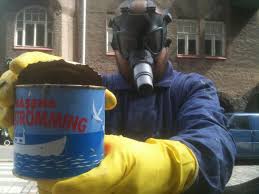Writing a blog over the Easter weekend, I realised this year has brought together three religions – Easter, Passover and Ramadan. Once, Good Friday was a closed holiday for Christians. You vaguely knew the Jews had a festival about that time. Ramadan? Who had heard of Ramadan!
I was born into a Christian country. No multiculturalism in this Australia – and that went for the Aboriginal people as well.
In my mind, from when I was a child, it was a day of mourning. You ate fish, which was generally South African cod, that orange smoked hake which, when poached, provided a ritual assault on your taste buds. You stayed at home after church. It was a day bereft of any jollification.

I remember I once went to a vigil at midnight at St Peter’s Eastern Hill, which is the nearest Anglican Church in Melbourne to liturgically resemble the Roman Catholic Church. It is a beautiful church tucked away on the fringes of East Melbourne and Fitzroy. I went there on impulse near midnight on Maundy Thursday, on my way home when I was living in East Melbourne. I was walking alone and feeling somewhat hollow.
The church was dark with guttering candles. In the indigo darkness, I could make out a number of shadows praying and in the poor light I could distinguish one young woman, who was deeply bowed and obviously upset. I kneeled some way from her in the row of pews behind, but she maintained the expression. She did not sob, nor utter a sound. It seemed that she had been consumed by the moment of a figure with a crown of thorns weighed under the Cross he bore. In the darkness it was the only time I felt I was a bystander, watching somebody consumed, almost living the event in her mind. I stood up and left. The hollowness had not left me; I did not sleep well for the remainder of the night.
Now, years on, Good Friday is the first day of a holiday with hot cross buns and very little religion. The Crucifixion story is too grim, and any media coverage is minimal amid the flush of sporting events and other recreational activities around some Easter leporine vermin encased in chocolate.
This Easter, the airlines certainly injected a bit of pain on the road to the airline seat, maybe invoking the need to have the crowning thorn of too few staff to handle the crowd. How beautifully the airlines converted the departure lounges to a road trudging towards a new Golgotha.
Maundy Money
Maundy is the Thursday before Easter and celebrates the day of the Last Supper; “maundy” refers to Jesus’ commandment to the disciples to “Love one another as I have loved you.” Maundy is a corruption of the Latin for command – “mando” – which incidentally also means “chew” – hence the lower jaw – mandible – and thus another association with the Last Supper. Jesus was actually celebrating the Seder, the ritual meal in which the liberation of the Israelites from Egypt is celebrated by Jews marking the start of Passover.
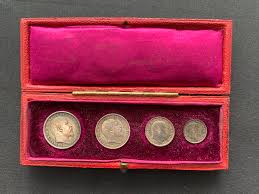
Maundy Thursday follows a giving of alms to the poor, a practice commenced by King John. The nature of the alms has changed, settling for these coins given by the British sovereign to the “deserving poor” in a number of sets equivalent to the age of the monarch in each year. In 1902 Edward had just succeeded his mother and was 60 years old, and while that number was distributed at the Royal Maundy service, a great many more sets were minted – and therefore the value of a set, in good order has varied, but currently it is around AUS$250 for a 1902 set.
Although the coins are ensconced in an impressive case, mine is probably one of the surplus issue. As far as I can ascertain, it was given to my mother by a well-heeled lady called Mrs Wynne, for whom my mother was companion for several years. All very lavender scented and chintz.
My mother acquired some of the woman’s memorabilia, but the Maundy money seems to be the only remaining legacy. I vaguely remember my mother talking about her retiring finally to Bribie Island in Queensland, but my mother never visited her, although they may have corresponded.
The Member for Grayndler
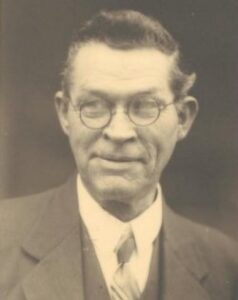
Edward Grayndler seemed to have been a reasonably competent if conservative union bureaucrat within the AWU, as it emerged from the Shearers strike of 1890. He opposed World War 1 conscription, but this opposition to Billy Hughes did not seem to harm his relationship with successive conservative governments. For most of his later life he was a member of the NSW Upper House, and the only impression he seems to have left was on the cushioned seat of the legislature.
His legacy – an electorate named after himself. But for how long, given there is a whole conga-line of present prime ministers from NSW who, as part of their requiem, will have electorates named after each of them in NSW. In the offing, once interred, are Keating, Howard, Abbott, Turnbull and Morrison. NSW will have at least five newly-named electorates over the next 30 years or so – if the planet lasts that long.
And Anthony Albanese, the current member for Grayndler?
I live in the electorate and have just received a technicolour brochure spruiking the life of the Honourable Albanese. I have never seen him, but as somebody said about being polled by Gallup, the man himself replied that you would be more likely to be hit by a bolt of lightning. To which the other said that she had been struck by lightning. Well, it may happen – I may meet my local member, but I’m probably more likely to be struck by a bolt of lightning.
The problem with Albanese is that he, as he proclaims in his brochure, has been in Federal Parliament for 26 years, and yet one may ask what has he done, what is his legacy? Turn to the brochure. He has provided an effective voice – bit of nonsense, worthy of Morrison. So, we read on … the tear-jerked deprived background is wearing a bit thin, as is the fact that he went to university before entering the political web to perfect the spin which seems to be Albanese – the Brochure.
When people say they do not know him, are they really saying that he has never done anything, never had an original thought in his life and moved round the web because he did not offend anybody, married another member of the web, procreated, divorced? Just an ordinary bloke from the suburbs.
But no, he wants the electorate to think of him as exceptional – deputy to Rudd – he, the first Minister for Infrastructure. “In the depth of the Global Financial Crisis, Labor knew that Australia needed to build its way to recovery.” Pause. And so?
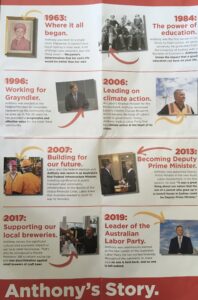 Then the drumroll – the achievement – supporting our craft brewers, no less. Set out in his brochure, he points out that he actually introduced a Private Members Bill to reform excise tax, and in his own words “end discrimination”. Reducing excise on grog is somewhat at odds with his first week of campaigning which concentrated on health matters.
Then the drumroll – the achievement – supporting our craft brewers, no less. Set out in his brochure, he points out that he actually introduced a Private Members Bill to reform excise tax, and in his own words “end discrimination”. Reducing excise on grog is somewhat at odds with his first week of campaigning which concentrated on health matters.
The first health thought bubble – the idea of having a registered nurse 24/7 in all nursing homes. This would require six registered nurses as a practical minimum for each nursing home; and in the current environment such a number is just not feasible – at least not immediately, despite the announcement that he, Albanese, will create thousands of university and TAFE places (although this was an afterthought to the GP emergency clinic idea). Where is the work experience for such a huge number, even if training could be rapidly expanded to cope?
Then this revival of the community health clinic, the variation of a general practitioner clinic attached to the emergency department. There is an underlying fallacy in this approach, which I shall expand on separately, but the Labor Party has received poor advice. The policy then only suggests 50 such clinics across Australia, hardly a generalisable policy in any event. This area, to those without experience in the field, may pass muster, but only in the nature of “Penguin Book Policy” that I mentioned in an earlier blog as the moniker for uninformed policy announcements.
What really put Albanese at a disadvantage with people who were looking for a viable alternative to Morrison was, on the first day of the campaign, the gigantic stumble in not knowing either the unemployment rate and, more disastrously in my view the cash rate, which has not changed for 17 months from 0.1 per cent. It did not get any better from there and makes one wonder, given the history from Beazley onwards, where does the Labor Party go for its models of leadership?
As I write this blog on Easter Sunday, maybe Albanese will start to rise to the task; and the proposal for an Integrity Commission is a very good place for him to start.
One thing he should remember is to pick on the topic where the Government is vulnerable and then hammer it. Add a pinch of climate change and the country being held to ransom by the very wealthy “oligarchs”, whose wealth has been tied up in fossil fuels, and the formula becomes stronger. However, whether Albanese can dispense this prescription will unfold over the next little while.
A Fraying Health Policy
The Labor policy to set up a stream of 50 general practitioner clinics to “treat patients needing urgent care including for broken bones, minor burns and stitches for cuts” is the same old policy under a different name – remember the investment in such community health clinics – the one stop shop. The pilot for general practice under the reign of Nicola Roxon was in Cootamundra, where the local general practitioner convinced the government to invest in a one stop shop clinic, next to the hospital. It has not been mentioned in the new Labor party policy and when I looked at the practice today, they still had six doctors and a general practice registrar. It seemed a conventional general practice and the waiting time to see the doctor seems to be currently two weeks – and no weekend work. So much for the pilot program.
 When I devised the “Murray to the Mountains” intern training program in North-East Victoria early in the last decade, I planned that each intern would spend 20 weeks in general practice in their first year, and the practices were linked to the local hospital, where they would be confronted with emergencies as well as consolidating their medical, surgical and emergency terms at the local regional hospital. As many of the regional specialists visited these general practice health services, this model enabled the interns to gain even more experience. There were none of these extravagant waiting times to see a doctor and weekends were covered.
When I devised the “Murray to the Mountains” intern training program in North-East Victoria early in the last decade, I planned that each intern would spend 20 weeks in general practice in their first year, and the practices were linked to the local hospital, where they would be confronted with emergencies as well as consolidating their medical, surgical and emergency terms at the local regional hospital. As many of the regional specialists visited these general practice health services, this model enabled the interns to gain even more experience. There were none of these extravagant waiting times to see a doctor and weekends were covered.
After all, an intern should be able to resuscitate and stabilise a patient with a medical or surgical emergency until they patient can be transferred to the appropriate medical service. The visiting geriatrician was able to take them around the nursing home to teach them how to treat the chronically ill.
Internship is a time for developing the experience and skills in how to deal with emergencies and incorporate the skills learned early into the doctor’s practice. Needless to say, being able to work with other health professionals, as distinct from just telling everyone what to do, is a skill which the interns learn in such a program. Many of the overseas trained male doctors had problems with women being considered equal and that was an issue confronted. On the other hand, after one of the specialists asked an intern why he was not eating, this led to a regionwide program to understand Ramadan among the non-Muslim health professionals to avoid such a question in the future.
A policy which assumes that a form of community health centre can relieve the hospitals of the burden of small surgical procedures is naïve in the extreme, given what has failed in the past. The more realistic demand is to ensure that all general practitioners have a basic set of skills to deal with emergencies (hence the program to ensure the interns have equal exposure to all basic skills).
The “Murray to the Mountains” Intern Training Program is ongoing, with checks and balances regularly set which eliminate that I-will-scratch-your-back-if you-scratch-mine mindset, which needs weeding out periodically from general practice. In other words, if you have an organised practice, as many do have, you can roster any of the doctors to cope with any emergency that arises, and be assured of a similar basic skill set. In the unlikely case of needing more, you will have a second on call. In the end, there will always be the unpredictable disaster, when you need everybody to help, but be assured that each person is able to be the frontline response in such a situation. It is a matter of priority in such situations.
Whatever you call it, community practice is medicine practised by a group with a patient catchment that the doctors themselves accept as reasonable. The service must be assured for 24/7. The problem is that these days one person practices are just non-viable, because in addition to struggling to provide essential locum cover when required, they fail to deal with the basic challenges of practice which I enunciated years ago – social dislocation, professional isolation, community tolerance and succession planning.
In most areas, professional succession planning is completely ignored or done badly. The thought of retirement in many cases is always a situation which doctors hate to confront until too late.
Community tolerance is the ability to integrate with the local community while maintaining professional integrity. When everybody knows everybody else, privacy is very difficult to maintain, but a medical record is not something for the parish noticeboard. Professional isolation is one area which has been addressed, but social dislocation (as I defined it, where the spouse or partner refuses to come with you or where you need to send the offspring off to school) is a matter of the family choice, which may not accord with the practice objectives. And do not underestimate the fear of rural life for those who had not had the opportunity to be socialised by stints with country relatives as a child.
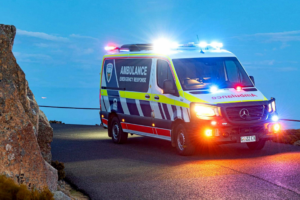 I have experienced medical care in a remote part of Tasmania. I needed the visit from a paramedic, not a doctor, at four in the morning. The paramedic had to come from a neighbouring town. He was quicker in responding than was the case with a similar call in Sydney, where the paramedic came from another suburb. What would a community health service along the ephemeral good-feel media announcement done for me – in a word nothing – at least not at 4.00 am as the paramedic did.
I have experienced medical care in a remote part of Tasmania. I needed the visit from a paramedic, not a doctor, at four in the morning. The paramedic had to come from a neighbouring town. He was quicker in responding than was the case with a similar call in Sydney, where the paramedic came from another suburb. What would a community health service along the ephemeral good-feel media announcement done for me – in a word nothing – at least not at 4.00 am as the paramedic did.
Albanese’s follow up thought that there be 20,000 new university places and extra TAFE places does nothing to reassure … at best it would take around 4-5 years for non-medical graduates and 6-7 years for medical graduates to be available for such clinics. Yet another workforce issue.
The problem with these announcements is that they are ill thought out, and the money ends up in some entrepreneur’s pocket – close to the political party promoting the policy bubble. Sound familiar, mate?
Tell me where I can charge the electric car
I want somebody to tell me when electric cars will be available. In the doggerel; this year, next year, sometime, never. “Never” seems to be the winner. Everybody says that, according to the populace at large, climate change is of overwhelming importance.
As somebody for whom a car has been a utilitarian means of going from one point to other, the rise of the electric car has been of interest.
Electric car sales in Australia only represent 0.78% of new cars, compared to Norway at 75% and the world average of 4.2%.
Our car is diesel. It is a Citroen C4, been reliable and for somebody who is disabled, surprisingly friendly. Nevertheless, it runs on diesel fuel and, at some time in the near future, we shall have to change to an electric car. When we enquire from the car dealers, they say there is no incentive for the car manufacturers to import cars into Australia. In fact, there were plans to dump fossil fuel driven cars in Australia because of the Government’s reluctant climate policy. Given Australia has no car industry, a casualty of globalisation, we are prisoners of fortune.
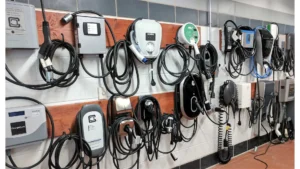
My interest was stimulated by an article in the Boston Globe, which canvassed the effect of the electric car in Massachusetts with its population of 7 million people. In America, they are still expensive in relation to the fossil fuelled cars; and importantly they estimate that they have only a quarter of the approximately 20,000 charging sites that are needed – for a population concentrated and about a quarter of our own population.
The problem is further compounded by the fact that fast charging cannot be done domestically, the required voltage is too great. Then there is a need to ensure that the electric car one buys is equipped with a plug for fast charging. There are about 300 fast charging stations in Australia, but some can only be used for Tesla cars at present. Given that it takes half an hour to charge a car, even using a fast charger, there is just no incentive for Australians to buy electric cars. It will need a massive investment, and nobody is prepared to invest in such a venture.
In Massachusetts, there are several legislative proposals designed to ease the financial stress of buying an EV for Massachusetts residents. One bill would expand the current state rebates for electric cars and extend them to used cars. Another would create more incentives for low- and moderate-income households, authorise more funding for the state’s rebate program, and expand the public charging infrastructure.
Tell me I’m wrong, but here we go again throwing money away on a Commonwealth Games and an Olympic Games – our politicians can’t get out of the “bread and circuses” routine; for them the end point is being able to view the circus from the emperor’s box sipping champagne and munching canapés.
 It really is a bit pathetic; building one sporting venue after another when Australia needs to seriously address climate change – and the electrification of our cars, trucks and buses is just one of the priorities to accommodate this need. This is a nation with a trillion-dollar debt, financing an indulgent yet flimsy infrastructure so a few of one’s mates can own expensive jets, buy huge boats to cruise The Mediterranean and when the day is done, après-ski at Aspen.
It really is a bit pathetic; building one sporting venue after another when Australia needs to seriously address climate change – and the electrification of our cars, trucks and buses is just one of the priorities to accommodate this need. This is a nation with a trillion-dollar debt, financing an indulgent yet flimsy infrastructure so a few of one’s mates can own expensive jets, buy huge boats to cruise The Mediterranean and when the day is done, après-ski at Aspen.
Reminds me of the late Peter Sarstedt song “Where do you go to my Lovely” … could be the anthem of this country as it flounces towards oblivion.
God what were they thinking – Shock Horror
Who would have thought? There is the photo taken of me peering through the sunflowers outside florista just before tucking into a lunch of passatelli – a form of ragú – washed down with a Piedmontese red. Drinking such a wine reminded us that we had come into one of the smallest self-governing republics in the world and reputedly the oldest, being founded in 301 AD. This was San Marino, wedged between the regions of Emilio Romagna and Marche, a leisurely drive from our favourite city in Italy, Ravenna. After Nauru, it is the smallest Republic on Earth.

Like many of these tiny European countries it exists on rocky outcrop and has survived all the vicissitudes over the centuries of a city-state weathering the ambitions of the Borgias, the imperial dreams of Napoleon and a brief occupation by the German army during World War II. One of the souvenirs is to have a San Marino euro, even although it is not part of the EU.
The republic has just appointed as one of its two Captain Regents, Paolo Rondelli. A true Sammarinese, he is the first openly gay Head of State. There are openly gay heads of government in Ireland, Luxembourg, Serbia, and Iceland, but no Head of State.
Australia has a way to go – Morrison and Hurley do not exactly fill the bill of the first openly gay Prime Minister and Governor General in the Southern Hemisphere.
Nevertheless, as a head of government, Don Dunstan, as South Australian Premier from the late 1960s, was way ahead of the field of legislators in the Gay Stakes. Pity the Labor Party do not have anyone of that calibre now.
Mouse Whisper
I read this exchange as I trawled through the eek-mail to find this exchange:
Well J

Indeed surströmming has a very special stink, most portraits of consumers include a clothes peg on their nostrils.
The fermented stench is reserved for closed groups and needs booze in quantity as well as a special mood. Not possible to serve in restaurants if you want to keep your other customers
Cheers
M
Earlier:
M
“To the Swedes, there are few odours more delectable than the scent of surströmming…to most non-Swedes there are probably few odours more repulsive.”
This was in April 9 copy of The Economist page 64. I can’t remember this on any Swedish menu – I associate this with Iceland.
J
